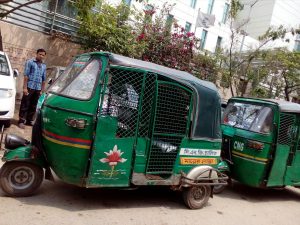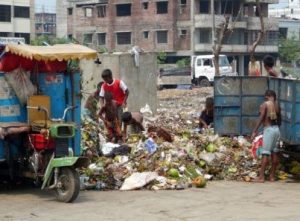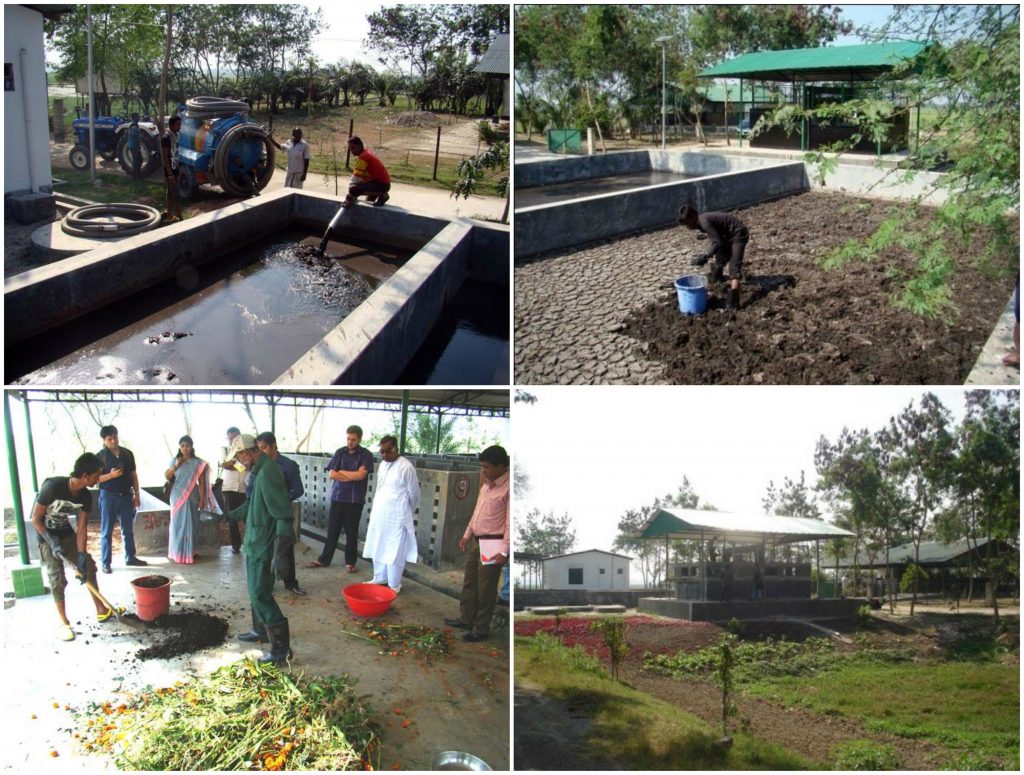Innovative waste to resource conversion and greenhouse gas reduction in Bangladesh
***
There was an omnipresent brown haze outside the window as we flew east, obscuring the beauty of my native Bangladesh. The thick smog that spewed from a myriad of brick firing stations, steel manufacturing factories, and power stations was a sign of rapid and unsustainable industrialization. After a few bumps and rolls, the aircraft peaked under the haze, revealing the country below: a nation the size of New York state, and home to 160 million people. It was easy to see why this land had been such a prized possession for numerous colonizers. The country is covered with a beautiful tapestry of lakes, intertwining rivers, and lush green rice paddies. The fertile delta was under the rule of the Mughal Empire for 300 years, and then conquered and strictly controlled by the British East India Company for nearly 200 years. When the British left the area, new political borders were negotiated, seemingly with a vague grasp of (or lack of concern for) national identities. The arbitrary boundaries left present day Bangladesh with limited natural resources and a largely poverty-stricken population.
Forty-six years ago, there was another massive change for Bangladesh: a bitter civil war that lasted over nine months, and claimed three million innocent lives. To this day, if you stop to listen, you are still likely to hear vivid recollections of lost parents, grandparents, aunts, uncles, brothers and sisters. Politicians, professors, doctors, and students were brush-fired on the streets, and women raped in an effort to keep Bangladesh from progressing towards an independent future. Nevertheless, through guerrilla warfare and some international assistance, Bangladesh gained independence on the cold, foggy night of December 16, 1971.
Since that day, Bangladesh has come leaps and bounds. It has established itself as a secular nation with large Muslim, Hindu, and Christian populations. The country observes all major religious holidays, including Christmas. Economic growth has hovered at 6-7% per year, and political stability has attracted foreign investments that have made the country home to the largest garment industries in the world. However, exponential economic growth from a gas boom in the early 2000s has brought exponentially growing problems.
The capital city of Dhaka is now home to a staggering 16 million people, and faces a major challenge in waste retrieval, processing, and disposal. Almost 50% of the 5,000 tons of waste produced every day remains uncollected on road corners, open sewers, and the edges of ecologically important wetlands. Furthermore, open dumping, which often contains dangerous medical waste, spreads deadly diseases and contributes to greenhouse gas emissions, as the waste anaerobically digests itself.
Recognizing the magnitude of the waste problem, in 2007 urban planners Maqsood Sinha and Iftekhar Enayetullah designed a new composting technology to reduce carbon emissions from open dumping. This system enables the organization to sell carbon offsets in the global carbon market. Their work has since received international recognition and has been replicated in several other countries.
***
After graduating from college in the United States, I returned to Bangladesh with an interest in contrasting sustainability initiatives in developed verses developing countries. While I was working on a project giving microloans to low income community members, I had the opportunity to meet Mr. Sinha and Mr. Enayetullah. We were guests on a panel for socially responsible environmental businesses, and they spoke about their decentralized composting system as a way to empower communities through local employment. I was transfixed by the work of these two social and environmental change-makers, and ended up working with them for two years prior to my graduate studies.

As we traveled along the winding roads, the towering, haphazardly built buildings hid most of the winter sun. Whatever light was visible spiraled down along the ubiquitous smog. Foreign visitors are often surprised to learn that a vast majority of waste is recycled in Bangladesh. This arduous work is done manually by an informal network of waste pickers: thousands of women and children, locally known as “tokais” or “one who picks.” Still, along the road there were endless piles of rotting vegetable matter, peppered with broken glass and what seemed to be medical waste from hospitals, all of which made us feel as if we were in some dystopian world. There are laws designed to have medical waste processed separately, but they have little effect, especially in smaller clinics. As with many issues in developing nations, regardless of policy, implementation is a major hurdle due to lack of capacity building and funds.

After a grueling three-hour journey in the baby taxi, we managed to spot the small gate of the environmentally-friendly composting plant. It was located in a rather macabre area, surrounded by massive factories churning out the latest garments to be shipped out to affluent foreign buyers in Europe and the United States.
Mr. Sinha, co-founder of the plant, greeted us at the gate. A tall man, dubbed a “tower of knowledge” by the local media, he immediately launched into his vision: “amidst the waste there is an economic opportunity hiding.” We learned that unlike waste in developed countries, which is primarily packaging materials, waste in poorer countries in Asia is almost 70% organic, with high moisture content and low calorific value. Due to the moisture content (because of the large number of vegetable matter and incessant monsoon rains), the waste cannot be efficiently incinerated and thus, the best option is to churn it into compost.
The plant is home to the Recycling Training Center, a novelty when the building first opened in 2007. Government officials, plant managers, and investors come from all over the world to study the state-of-the art system of decentralized garbage collection, processing, and sale of high quality compost. The team at the plant also helps design and replicate similar centers, and have successfully done so in Vietnam, Cambodia, Sri Lanka, and Nepal. This particular plant is able to accept seven tons of waste per day, turning one-fourth of it into high quality compost. The center reduces over 1,200 tons of carbon emissions per year: that is the amount of carbon that would be emitted into the atmosphere if the waste sat in a landfill releasing methane, rather than being processed. In addition to compost production, the center also researches biogas production using regular household organic waste to produce methane gas for cooking and to run a gas-powered generator. They also harvest over 584 cubic meters of rain water every year, recycle 438 cubic meters of waste water, and installed solar panels which save the site 1095 kW hour of electricity per year.
We were especially glad to learn that the center hires local community waste pickers (no children are involved), and provides them with sanitary boots, gloves, a mask, and a fair wage. Furthermore, the site has an on-call doctor and a childcare center, and a small kitchen, which provides a free lunch of rice, lentils and a protein of fish or meat.
As guests to the site, we were spoiled over lunch. We ate khichuri, a deliciously heavy local delicacy of lentils and thick-grained starchy rice cooked with aromatic spices. A generous, heart-stopping dollop of ghee, a rich, clarified butter, was poured over it, and topped with deep fried onions. There was a side of pickled mango, and sundried red-hot chilies for us to rub our rice with: perfect for a cold, damp winter day.
***
After a brief overnight stay at a questionable local motel, we made our way to the next site. The co-composting plant (called so because it has two input materials: household waste such as vegetable matter, and human night soil) handles four tons of human waste per day. Waste is dried over a bed of what can only be described as something like an upturned Brita filter, consisting of layers of sand, stones, coals/carbon and coconut husk fibers, and the water seeps through to a holding tank. Once the solid waste is dried, it is mixed with compostable materials from local markets and households.

Although the initial concept of the plant was welcomed and supported by the city officials, it was a taboo topic in local communities. To some, the idea of mixing human waste-based compost sounded repulsive, even sacrilegious. But at this point, I was sold: if we can use cow manure to enrich our fields, power our stoves, what is wrong with using manure from other species of the animal kingdom? It was good to hear that the community views of using human waste were changing. Hopefully one day it will be a commonly accepted form of effective and cheap soil nutrition not only in Bangladesh, but in the United States as well. As we are pushed into using more advanced machinery and technology to address environmental issues, we cannot overlook the innovative decentralized and locally implemented solutions that have been highly successful. Climate change and environmental degradation follow no geo-political boundary, and our solutions must be equally diverse.
After fully digesting the facts and figures of the plant, and being inspired far more than expected, it was time to go. The winter sun was setting and we were advised to leave before it got completely dark. Having had cajoled my friends to use the rather dangerous baby-taxi on the ride to the plants, we splurged a few extra dollars on a proper rental car on the way back, much to our joy and relief.
To learn more about the waste to resource conversion plants please visit www.wasteconcern.org